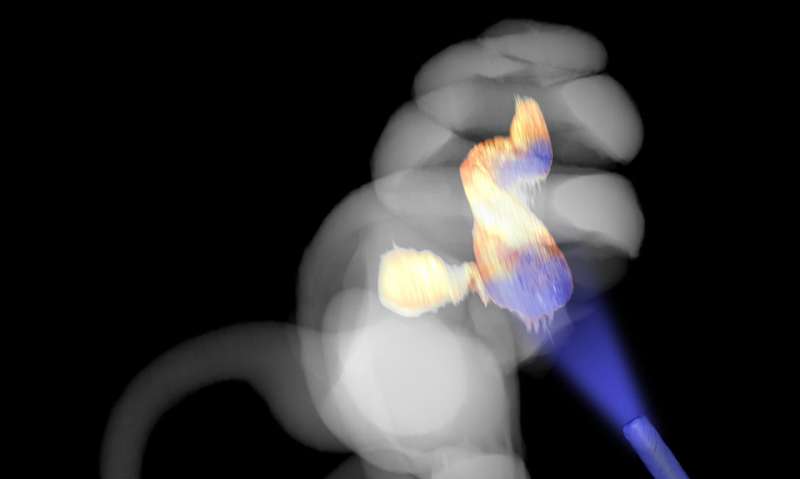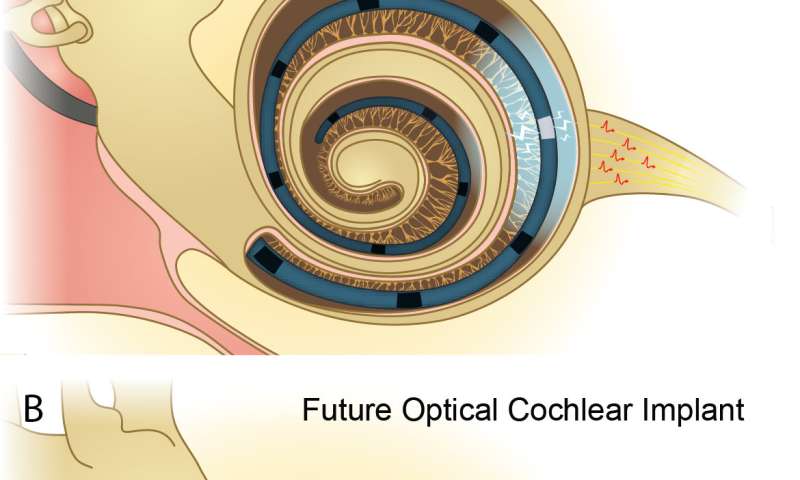July 12, 2018 report
Light based cochlear implant restores hearing in gerbils

A team of researchers with members from a variety of institutions across Germany has developed a new type of cochlear implant—one based on light. In their paper published in the journal Science Translational Medicine, the group describes their new implant and how well it worked in test gerbils.
Over a half-century ago, scientists came up with a way to partially restore hearing in people with cochlear damage—a cochlear implant. The same basic technology is still in use today—such devices work by converting sounds to electrical signals, which are transmitted to neurons that carry the signal to the brain. And while the implants have helped many people to hear, they still suffer from one major problem. Too many simultaneous sounds, such as speech in a crowded room, become muffled. This is because the electrical signals run into one another, causing degradation of the messages carried to the brain. In this new effort, the researchers have converted sound to light instead of electricity, because light can be directed more precisely.
The new implant fires light directly at cochlear neurons. But for that to have an effect, the researchers had to get the neurons in test gerbils to respond to it. To make that happen, they injected a virus carrying gene encoding for light sensitivity directly into the cochlea. To test their device, they trained some gerbils to jump from one part of their cage to another when they heard a certain sound before the device was implanted. Afterward, light from the implant was activated and that caused the gerbils to jump as they had before, showing their brains were receiving the same signals. Next, the team caused cochlear-based hearing loss in the test gerbils and once again fired up the new implant. They report that the gerbils jumped just as they had in response to the prior sound, proving their hearing had been restored.
The researchers suggest their device is a proof of concept for a way to improve cochlear implants. The next logical step would be to add electronics to the device to convert sound signals to light, which would then stimulate neurons in the ear in the same way electrical signals have done in the past.
-

(A) electrical cochlear implants contain 12-24 electrodes which typically provide less than 10 independent frequency channels for users. This is due to the fact that current spread (light blue shade) leads to activation of a large population of neurons along the frequency axis of the cochlea and thereby limits the frequency resolution and dynamic range of electrical coding. (B) optical stimulation promises spatially confined activation of neurons in the auditory nerve allowing for a higher number of independent stimulation channels and, thereby, improving frequency and intensity resolution using future oCIs. (C) this preclinical animal study used single channel optical stimulation by inserting an optical fiber into the cochlea. Credit: University Medical Center Göttingen, Germany -

Schematic illustration of the newly proposed optical cochlear implants. A strip of LEDs is inserted into the snail shaped cochlea. Optical cochlear implants promise spatially confined activation (blue shade indicates light from activitated LEDS) of neurons in the auditory nerve allowing for a higher number of independent stimulation channels and, thereby, improving frequency and intensity resolution. Credit: University Medical Center Göttingen, Germany
More information: C. Wrobel el al., "Optogenetic stimulation of cochlear neurons activates the auditory pathway and restores auditory-driven behavior in deaf adult gerbils," Science Translational Medicine (2018). stm.sciencemag.org/lookup/doi/ … scitranslmed.aao0540
© 2018 Medical Xpress

















